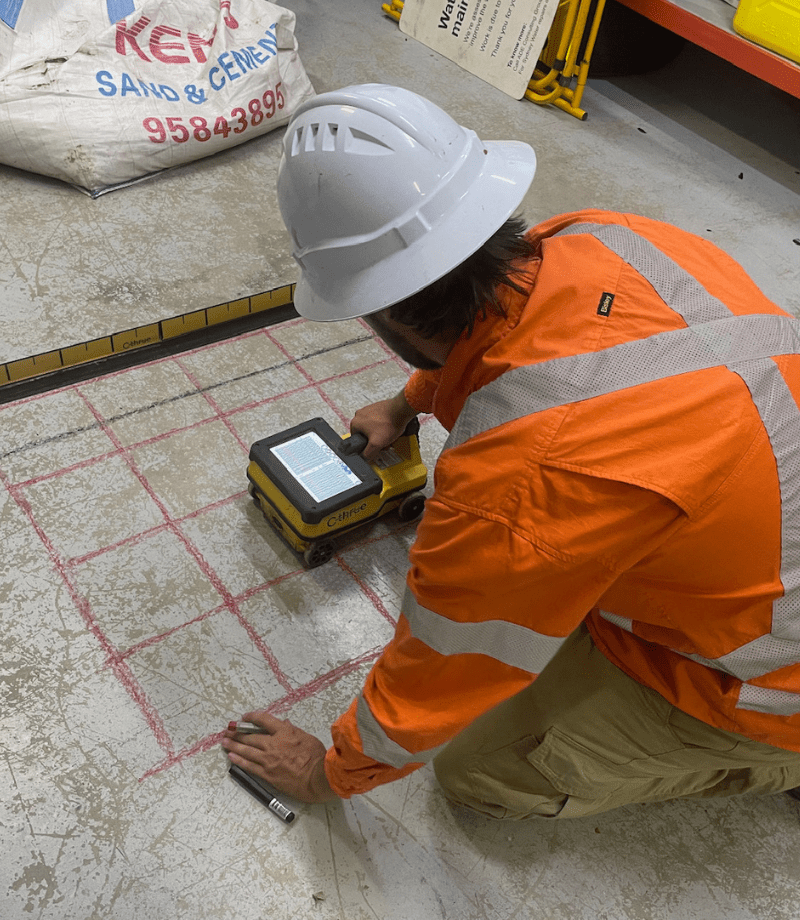Elevate Your Construction Refine With the Strategic Insights of Concrete Scanning for Boosted Productivity
One such innovation that has transformed the building and construction market is concrete scanning. By harnessing the strategic understandings given by concrete scanning, building and construction experts can open a world of enhanced productivity and structured procedures.

Advantages of Concrete Scanning
Enhancing job performance and safety, concrete scanning uses a non-destructive approach for identifying hidden items within concrete frameworks. By using modern technologies such as ground-penetrating radar (GPR) and concrete x-ray imaging, building groups can accurately find rebar, post-tension cable televisions, electric channels, and various other blockages prior to exploration, reducing, or coring into concrete.
The advantages of concrete scanning are numerous. It reduces the threat of unexpected damages to vital architectural elements, lowering the possibility of costly repair work and project delays. It enhances employee safety by providing real-time insights right into the location of surprise risks - Concrete Scanning. Building and construction sites can be complex environments, and recognizing what exists underneath the surface area can avoid mishaps and injuries.
Moreover, concrete scanning promotes total job performance by preventing and streamlining process rework. By determining prospective issues beforehand, groups can change their plans proactively, conserving time and resources in the future. Basically, the adoption of concrete scanning innovations is a calculated financial investment that pays dividends in regards to productivity, safety and security, and cost-effectiveness.
Modern Technology Combination for Performance
Concrete scanning's ability to enhance operations and boost job efficiency can be additional optimized through calculated assimilation of advanced modern technologies. By integrating Structure Information Modeling (BIM) software application right into concrete scanning procedures, construction groups can achieve a greater degree of accuracy and sychronisation. In addition, the assimilation of Increased Reality (AR) technology with concrete scanning can boost on-site visualization, allowing project managers and workers to overlay digital info onto the physical setting in actual time.
Avoiding Costly Mistakes
Just how can thorough focus to detail throughout concrete scanning procedures assist construction teams in preventing costly mistakes? Concrete scanning plays a vital duty in identifying potential issues before they rise into expensive mistakes. By making use of sophisticated scanning modern technologies such as Ground Penetrating Radar (GPR) and electro-magnetic induction, construction teams can accurately discover rebar, utilities, voids, and other blockages within concrete structures. This level of precision enables job supervisors to make educated decisions concerning the layout and design of their building strategies, decreasing the threat of unexpected damage to vital infrastructure throughout the structure process. Additionally, concrete scanning aids in making sure structural integrity by recognizing weak points or issues in the concrete beforehand, enabling prompt repair services and alterations. By proactively attending to these issues, construction groups can avoid costly mistakes such as rework, delays, or safety dangers that might develop from ignored inconsistencies in the concrete framework. Eventually, buying thorough concrete scanning treatments shows to be a cost-effective technique over time, saving both time and sources while enhancing overall job efficiency and high quality.
Enhancing Task Administration
Careful focus to information throughout concrete scanning processes not only aids in staying clear of costly errors yet additionally lays a strong structure for effective job administration in building and construction undertakings. By integrating concrete scanning technology into project management strategies, building groups can enhance operations, boost interaction, and ensure that projects stay on track.
Concrete scanning provides beneficial insights right into the architectural integrity of existing components, allowing task supervisors to check this make enlightened choices regarding design modifications or construction series. This proactive method reduces the risk of unforeseen hold-ups or remodel, ultimately saving time and resources. In addition, the data obtained from concrete scanning can be integrated right into Building Info Modeling (BIM) platforms, allowing real-time collaboration and control amongst numerous stakeholders.
Moreover, concrete scanning aids task managers identify prospective risks or obstacles prior to they intensify into bigger problems, advertising a much safer workplace for all included. With boosted exposure and accuracy provided by concrete scanning innovation, project supervisors can properly plan, monitor, and execute building and construction jobs with greater effectiveness and confidence.
Maximizing Performance
To improve performance in building and construction tasks, carrying out efficient approaches and making use of innovative modern technologies is important. Making the most of performance includes streamlining my review here processes, optimizing resource allotment, and decreasing downtime. One crucial facet of optimizing productivity is via the fostering of concrete scanning innovation. By making use of ground-penetrating radar (GPR) and other scanning techniques, construction teams can properly situate rebar, conduits, and other subsurface aspects, minimizing the risk of expensive mistakes and hold-ups during excavation and boring.
In addition, embracing Building Information Modeling (BIM) software can considerably enhance efficiency by producing comprehensive 3D designs that improve project visualization and sychronisation among different professions. BIM enables better clash detection, making it possible for problems to be recognized and dealt with before building even starts, conserving time and sources over time.
Executing a lean construction approach, which focuses on removing waste and maximizing effectiveness across all project stages, is an additional reliable technique for taking full advantage of performance. By promoting collaboration, interaction, and constant improvement, construction groups can work more cohesively towards accomplishing project objectives in a structured and efficient manner.
Final Thought
In verdict, the critical execution of concrete scanning in the building procedure offers countless benefits, consisting of boosted performance, price savings, improved task monitoring, and boosted performance. By integrating this innovation, building and construction groups can avoid expensive errors, enhance their procedures, and maximize their overall task outcome. Concrete scanning is a valuable device that can elevate the building procedure and bring about more successful and lucrative end results.
